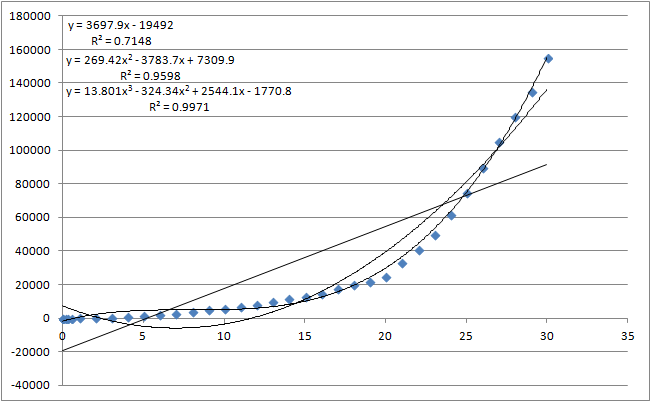I think the primary reason that Mistwell is unwilling to accept using CR for encounter building is because the encounter building rules are entirely incompatible with CR. There is no way that I can see to modify the XP budgets to accomodate using CR.
Yes, XP values are based on the CR of the monster. However, there is no reliable equation for determining a creature's XP from CR or vice versa. We need to use a chart that uses arbitrarily determined equivalents because there is no mathematical way to convert one value to the other. If CR could be used to determine encounter budgets, then we could deduce this equation, and it would fit the available data perfectly (R² = 1).
I decided to try creating an equation to convert CR to XP by plotting the values for both and setting linear and polynomial trendlines of second and third orders. Any equation that could be used for converting CR to XP must a) be a very near perfect representation of the CR to XP table (R² > 0.99), and b) have no significant anomalies.

Let's take a look at the equations we get, shall we.
The first one is a simple linear equation that correlates extremely loosely with the available data. With an R² value of 0.7148 it is safe to say that it is entirely nonrepresentative of the CR/XP charts.
The next one, a second order polynomial equation, is far closer to the values given by the CR/XP charts. With an R² of 0.9598 it is far closer to the data we have available. But look at the lower end of the CR scale, specifically between zero and twelve. If this equation is correct, extremely low CR creatures grant over 7000 XP, while CR 3-12 creatures grant negative experience. This would count as a significant anomaly.
Finally we have the third order polynomial. This equation is extremely close to the CR/XP tables (R² = 0.9971), and has no glaring errors at a glance. However, consider the complexity of the equation. I have serious doubts that WotC decided upon the equation y = 13.801x
3 - 324.34x² + 2544.1x - 1770.8 to determine the XP for a given CR. It is highly unlikely that anyone would suggest such a lengthy and unwieldy equation is used for a version of D&D that emphasizes simplicity to such a great extent. It also gives negative experience for CRs below 1.
Because there is no clear and reasonable correlation between CR and XP values (at least not with the charts provided), it is unreasonable to assume that CR can be substituted for XP when using the encounter difficulty charts or that the two are closely linked.
If anyone has a simpler way to prove a relation between CR and XP, by all means show me. Being able to use CR to create balanced encounters would be far simpler than adding and multiplying XP values for several monsters. It's just that I cannot see that link, and thus dissociate the two.
Of course, this entire concept breaks down when you realize that XP, CR, and encounter difficulty are all more or less eyeballed in the first place...



